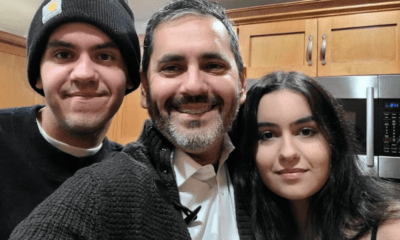INTERNACIONAL
Los relatos de las ocho cuadras frenéticas de un ómnibus que perdió el control y terminó en la playa de Montevideo

La imagen fue impactante: un ómnibus perdió el control, atravesó la rambla de Montevideo y terminó en la playa. Ese sábado, previo a las elecciones nacionales de Uruguay, la presencia de un bus en la arena llamaba la atención de cualquiera que pasara por la costanera de la capital uruguaya. El accidente sería fatal: con el paso de los días se confirmaría que una mujer falleció como consecuencia de las lesiones que sufrió.
El accidente ocurrió hace prácticamente medio año y, con el paso de los meses, los pasajeros comenzaron a contar sus relatos. Además, hay varios procesos judiciales abiertos.
Además de un juicio que busca responsabilidades penales, los damnificados por el accidente del ómnibus de la empresa Cutcsa pueden acudir a la Justicia civil en busca de una indemnización económica, informó semanas atrás el noticiero Telemundo de Canal 12.
“Es complicado continuar después de lo que pasó porque quieras o no tenés el miedo de que pase otra vez. O la incertidumbre de estar arriba un ómnibus te acompaña por el resto de tu vida. Cutcsa nunca se comunicó con ninguno de nosotros para ver cómo estábamos”, contó a ese medio Matías Muniz, uno de los pasajeros.
La oferta de la empresa como indemnización fue de USD 700. “Son cifras muy bajas y simbólicas. Es un valor simbólico para que no firmes por nada y que la investigación se cierre”, lamentó. “Parece que por tener suerte, no tener lesiones graves y no morir en el intento, Cutcsa no se va a hacer cargo de mi situación. Es una indignación muy grande por parte de todos los pasajeros porque sufrimos daños, tenemos secuelas en la parte mental y hay que seguir el día a día.
Todo cuesta plata, se quejó el pasajero. Muniz narró que tiene que pagar cuentas y que, si quisiera ir a un psicólogo para tratar el trauma, no le saldría barato.
El ómnibus que traspasó la rambla y quedó sobre la arena era de la línea 121 de la empresa Cutcsa. Es una opción que a Sandro no le gustaba tomar para ir al trabajo. El recorrido es demasiado largo y el viaje se le hace lento. Pero ese sábado fue particular: las otras líneas demoraban en llegar y se encontró a una compañera en la parada.
Así lo narró al semanario uruguayo Búsqueda, que narró las historias de otros pasajeros que se subieron a ese 121 ese día fatal.
Daniela era su compañera de trabajo y, desde el inicio, ambos notaron que un comportamiento extraño en el chofer. Para empezar, por el lugar en el que frenó para que subieran: estaba bastante lejos de la vereda. Luego, comenzó a cruzar semáforos en rojo, a saltearse paradas. A frenar. A acelerar.
Eran cerca de las siete de la mañana de ese sábado y había poco tránsito en Montevideo. Daniela en un momento pensó en tomarse un taxi, pero finalmente decidieron seguir en el colectivo. “Ya veníamos advirtiendo que algo le pasaba, que estaba quemado, estaba locazo, pero nunca imaginamos que iba a hacer esto”, contó la mujer.

¿Qué es “esto”? Cruzar el cantero central de una calle de Montevideo, acomodar el coche contraflecha y salir a toda velocidad hacia la rambla. “El tipo apretó el acelerador, pasó el cantero. Y después siempre me quedó la pregunta: ‘¿si estaba dormido, por qué no se dio contra un árbol’?”, señaló.
Fueron ocho cuadras frenéticas contra mano.
Además de Sandro y Daniela, había 13 pasajeros más. Y todos gritaban: “¡Pará, hijo de puta, nos vas a matar, pará!”. “¡¿Qué hacés?!”. Algunos se arrimaban a la puerta, tocaban el timbre para pedir que se querían bajar. Gritaban. Intentaban hablar con el chofer. Le pedían que frene.
Daniela se puso sobre el borde del asiento, casi en cuclillas, y escondió la cabeza en sus brazos. Sandro se agarró con fuerza de los asientos de adelante.
El ómnibus pasó a más de 100 kilómetros por hora por la calle, cruzó otro cantero, atravesó un muro y pegó un salto sobre las dunas de la arena hasta que se detuvo en la orilla del mar.

Sandro ahora necesita volver a trabajar porque vive de un seguro de paro que no supera los USD 350 Y no puede creer que el chofer esté en su casa, según relató a Búsqueda.
“Estoy quemado con la Justicia, que dice que se durmió el hombre. Ahora no vamos a arreglar nada. Ya lo que pasó, pasó. Capaz que tuvo un mal día, pero hubiera dicho: ‘bájense, que me voy a matar’. Y sí, matate sol. Yo qué tengo que ver si estás loco. No tengo rencor, no gano nada, pero espero que la Justicia se haga cargo. Fue un atentado. No quiso matar a todos. Una locura”, comentó.
corresponsal: Desde Montevideo
INTERNACIONAL
Former French President Sarkozy begins a 5-year prison sentence for campaign finance conspiracy
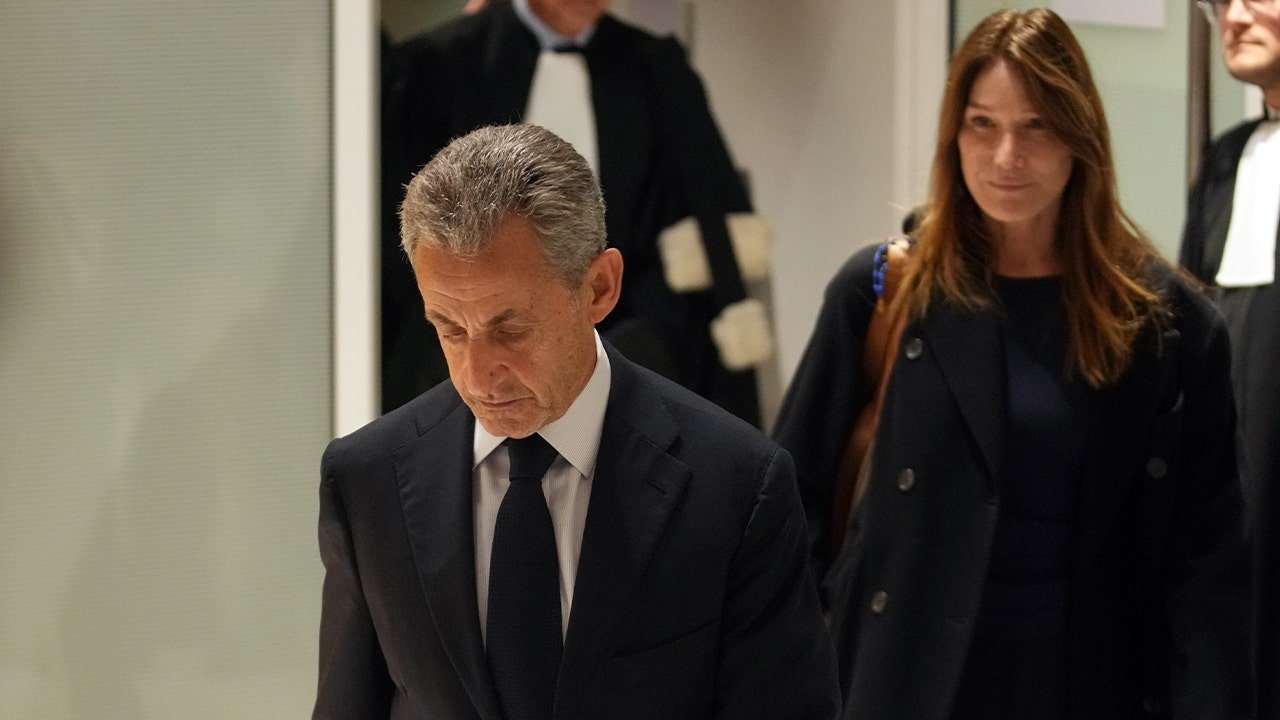
NEWYou can now listen to Fox News articles!
Former French President Nicolas Sarkozy entered a prison in Paris on Tuesday to begin serving a 5-year sentence for a criminal conspiracy to finance his 2007 election campaign with funds from Libya — a historic moment that makes him the first ex-leader of modern France to be imprisoned.
Sarkozy, 70, was greeted by hundreds of supporters when he walked out of his Paris home earlier in the day hand-in-hand with his wife, supermodel-turned-singer Carla Bruni-Sarkozy. He embraced her before getting into a police car.
Minutes later, the vehicle passed through the gates of the notorious La Santé prison — where Sarkozy will now serve his sentence in solitary confinement.
Sarkozy was convicted last month of criminal conspiracy in a scheme to finance his 2007 election campaign with funds from Libya.
He contests both the conviction and a judge’s unusual decision to incarcerate him pending appeal. His lawyers said Tuesday that they filed an immediate request for his release.
FORMER FRENCH PRESIDENT NICOLAS SARKOZY SENTENCED TO FIVE YEARS IN LIBYA CORRUPTION CASE
Former French President Nicolas Sarkozy and his wife Carla Bruni-Sarkozy leave their home on Tuesday, Oct. 21, 2025, in Paris as Nicolas Sarkozy heads to prison to serve time for a criminal conspiracy to finance his 2007 election campaign with funds from Libya. (AP Photo/Thibault Camus)
A show of defiance
«It’s an ominous day for him, for France and for our institutions, because this incarceration is a disgrace,» Sarkozy’s lawyer Jean-Michel Darrois told reporters soon after his incarceration.
In a show of defiance and while on his way to the prison, Sarkozy released a statement on social media declaring that «an innocent man» was being locked up.
«I will continue to denounce this judicial scandal,» he wrote. «The truth will prevail.»
Sarkozy told Le Figaro newspaper that he would bring three books to prison — the maximum allowed — including Alexandre Dumas’ «The Count of Monte Cristo,″ in which the hero escapes from an island prison before seeking revenge. He also picked a biography of Jesus Christ.
«I’m not afraid of prison. I’ll hold my head high, including in front of the doors of La Santé,» he told La Tribune Dimanche newspaper last week. «I’ll fight till the end.»
Sarkozy has repeatedly said he is the victim of «a plot» staged by some people linked to the Libyan government and denounced the Sept. 25 verdict as a «scandal.»
TRUMP COMMUTES GEORGE SANTOS’ SENTENCE, PARDON BLITZ WIPES OUT COSTLY FEDERAL INVESTIGATIONS
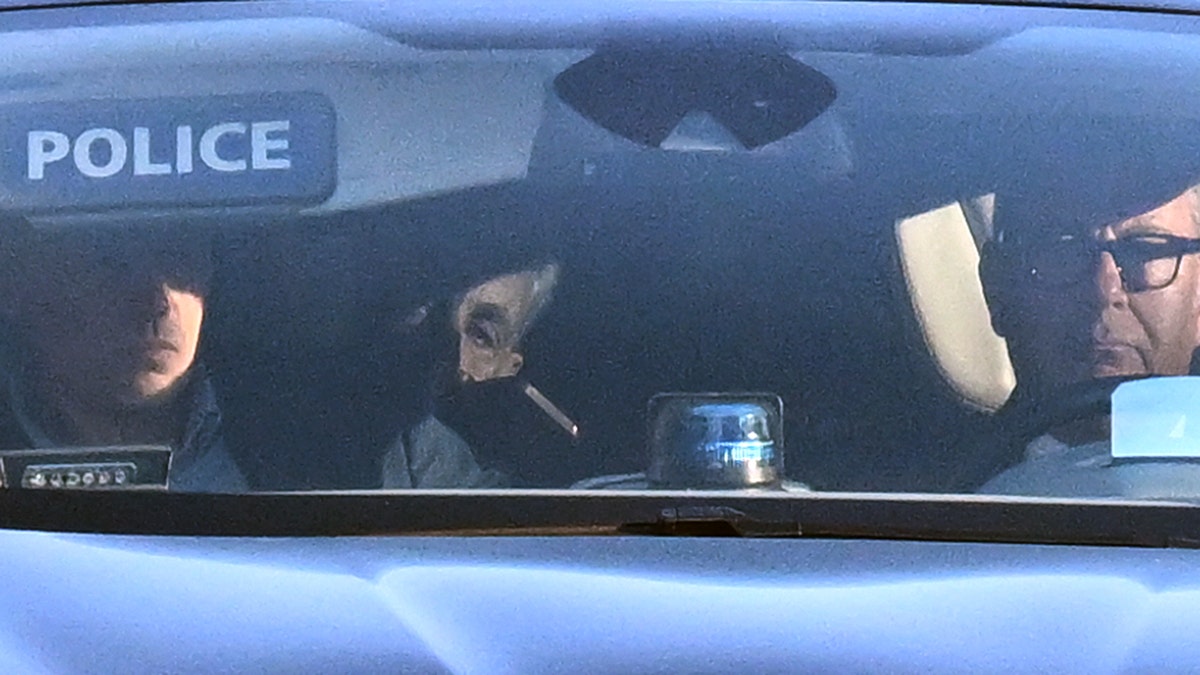
Former French President Nicolas Sarkozy, center, arrives at La Sante prison to serve time for a criminal conspiracy to finance his 2007 election campaign with funds from Libya, on Tuesday, Oct. 21, 2025, in Paris. (AP Photo/Emma Da Silva)
Solitary confinement
Sarkozy’s lawyers said he will be kept away from all other prisoners for security reasons. They said he packed a bag with a few sweaters because the prison is cold and earplugs because it’s noisy.
Christophe Ingrain, another of Sarkozy’s lawyers, denounced «a serious injustice.»
«It’s a very difficult time, but the president has stood strong,» Ingrain said. «He doesn’t complain, hasn’t asked for anything, no special treatment.»
Solitary confinement implies that Sarkozy will never see other inmates and will spend most of his time alone in his cell, Ingrain said.
He will be allowed to go outdoors one hour per day alone in the prison yard and to get three visits per week from his family, Ingrain said, adding that he is planning to write a book about his prison experience.
BRAZIL’S EX-PRESIDENT AND MAJOR TRUMP ALLY BOLSONARO PLACED ON HOUSE ARREST
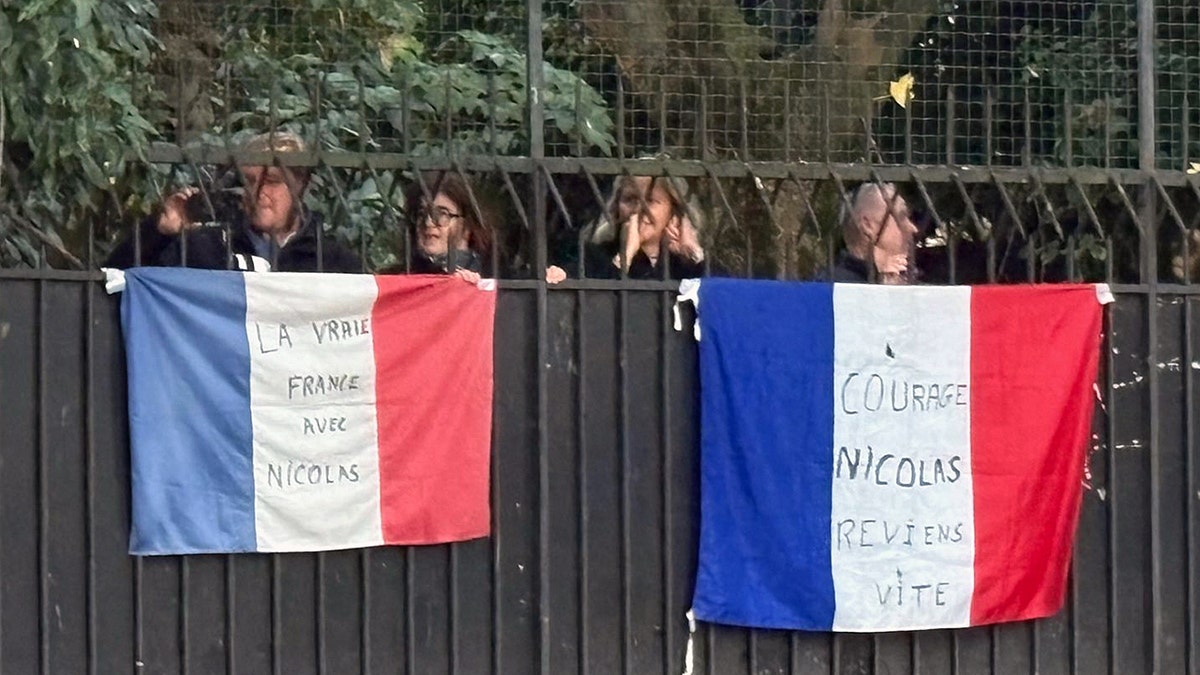
People stand behind French flags with inscription reading «Courage Nicolas, come back soon,» right, and «True France with Nicolas» outside former French President Nicolas Sarkozy’s home, on Tuesday, Oct. 21, 2025, in Paris. (AP Photo/Masha Macpherson)
An outpouring of support for the ex-president
Sarkozy’s journey from the presidential Elysée Palace to La Santé prison has captivated France.
After leaving their home, Sarkozy and his wife walked slowly to join family members, including his children and grandchildren, outside his home.
«I’m very proud to share his name, and very proud of how he’s reacting,» said his brother, Guillaume Sarkozy. «I’m truly convinced that he is innocent.»
Hundreds of supporters applauded and chanted «Nicolas, Nicolas» and sang the French anthem. Two French flags were hung on a nearby fence, with the words «Courage Nicolas, return soon» and «true France with Nicolas.»
Parisian resident Virginie Rochon, 44, came in support of Sarkozy, calling it «scandalous» to see «a former president being taken away while still presumed innocent.»
Another supporter, Véronique Maurey, 50, said: «it’s just not possible. And on top of that, calling it a ‘criminal conspiracy’ kind of makes all of us feel like criminals too, because we voted for him. It’s not right to say that.»
CLICK HERE TO GET THE FOX NEWS APP
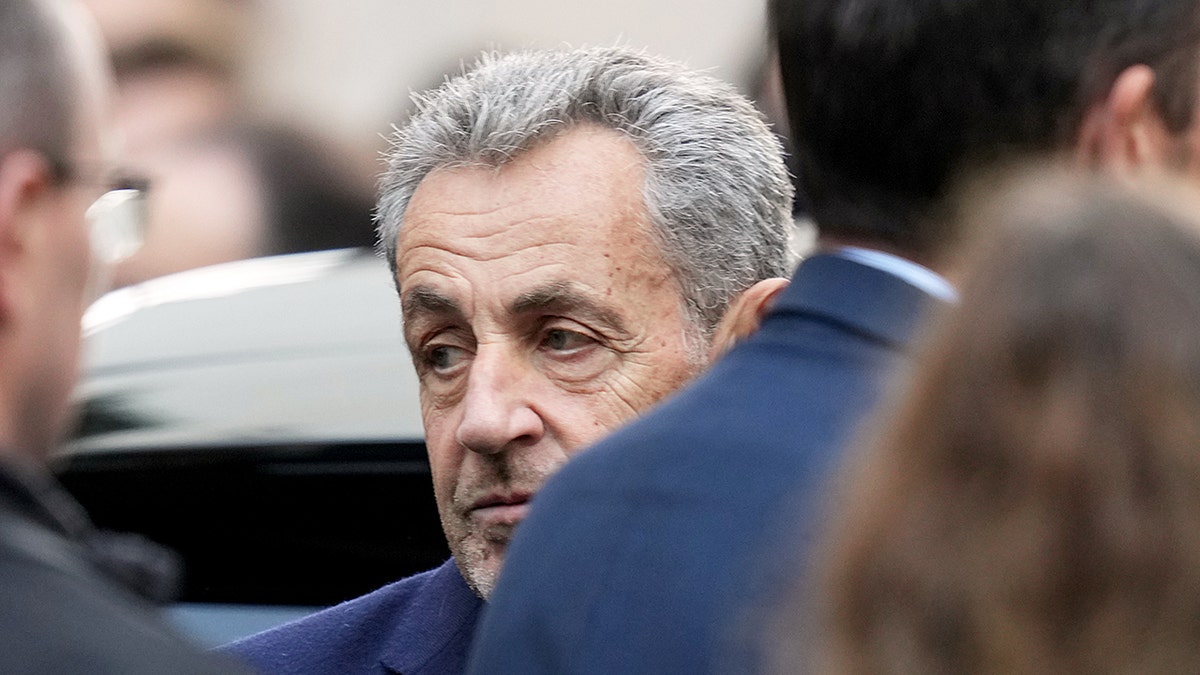
Former French President Nicolas Sarkozy reacts before entering a police car on Tuesday, Oct. 21, 2025, in Paris as he heads to prison to serve time for a criminal conspiracy to finance his 2007 election campaign with funds from Libya. (AP Photo/Thibault Camus)
Meeting with Macron
Embattled centrist President Emmanuel Macron hosted the conservative Sarkozy at the presidential palace last week, explaining it was «normal on a human level» to receive one of his predecessors in this context.
On Tuesday, Macron said he would not comment on a justice decision. «Nevertheless, it’s normal that the image of a president being imprisoned … may prompt comments,» he said.
«We must distinguish emotion, including the legitimate emotion of relatives and part of the country … and the proper functioning of justice,» Macron added.
Sarkozy has been retired from active politics for years but remains very influential, especially in conservative circles.
France’s top magistrate Rémy Heitz, Prosecutor-General at the Court of Cassation, warned Tuesday about a risk of «hindering (justice) serenity» and of «undermining the independence of judges,» including when the justice minister — a former conservative who joined Macron’s party — plans to visit Sarkozy in prison.
«The goal for everyone must be serenity, to allow justice to truly rule independently… free from any pressure,» Heitz said.
The Paris court ruled last month that Sarkozy would start to serve prison time without waiting for his appeal to be heard, due to «the seriousness of the disruption to public order caused by the offense.»
The court said Sarkozy, as a presidential candidate and interior minister, used his position «to prepare corruption at the highest level» from 2005 to 2007, to finance his presidential campaign with funds from Libya — then led by longtime ruler Moammar Gadhafi.
Under the ruling, Sarkozy was able to file a request for release to the appeals court only once behind bars. Judges have up to two months to process it.
france,associated press,world
INTERNACIONAL
Una hora de gimnasia diaria, lectura, escritura y tres visitas por semana: la nueva rutina de Nicolas Sarkozy en la cárcel
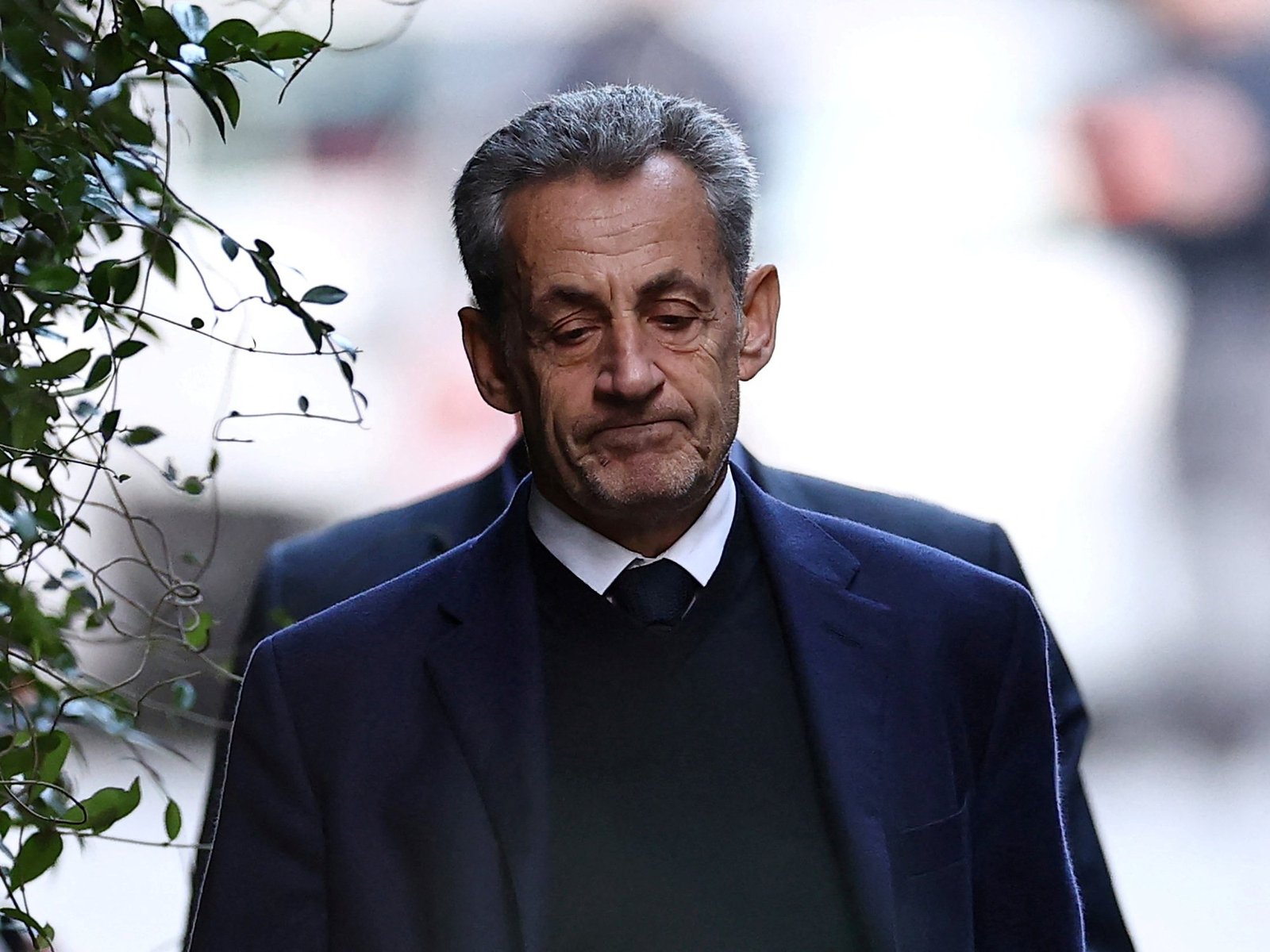
La Santé, una prisión muy antigua
Preso VIP
El último acto mediático antes de entrar a prisión
Carla Bruni, imputada
INTERNACIONAL
US military buildup in Caribbean sees bombers, Marines and warships converge near Venezuela
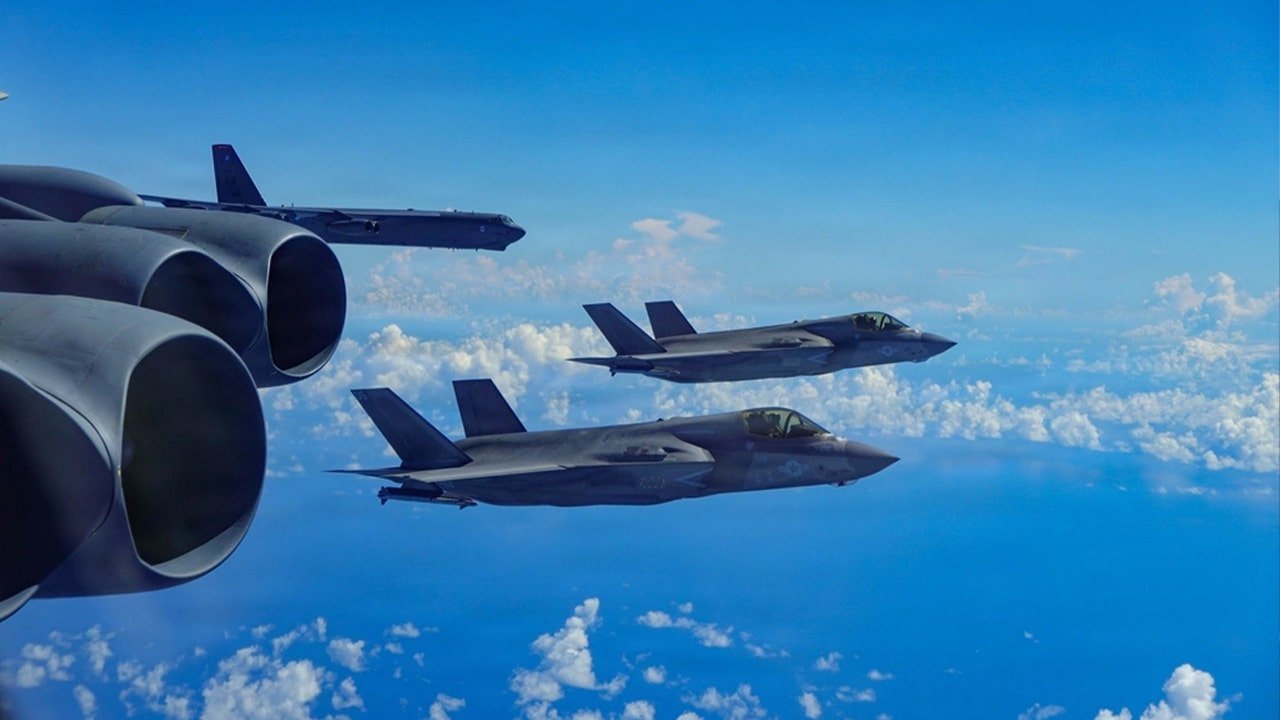
NEWYou can now listen to Fox News articles!
The United States has significantly increased its military presence across the Caribbean under U.S. Southern Command, deploying bombers, warships, and Marines as part of an expanded campaign targeting drug-trafficking and so-called «narco-terrorist» networks operating near Venezuela.
In addition to seven strikes on boats believed to be carrying narcotics, the Trump administration has built up thousands of troops in the region.
War Secretary Pete Hegseth this month announced the creation of a new counter-narcotics Joint Task Force operating near Southern Command, saying it was established «to crush the cartels, stop the poison, and keep America safe.» The task force will coordinate air, maritime, and special-operations missions across the region — marking the largest U.S. military effort in the Caribbean in decades.
U.S. Air Force B-52H Stratofortress bombers and Marine Corps F-35B Lightning II fighters recently conducted a bomber attack demonstration over the region — a show of force captured in Defense Department imagery. For four hours on Wednesday, B-52s from Barksdale Air Force Base in Louisiana patrolled near Venezuela’s coast in a display of military might aimed at Venezuelan dictator Nicolás Maduro.
TRUMP UNLEASHES US MILITARY POWER ON CARTELS. IS A WIDER WAR LOOMING?
President Donald Trump directed a deadly strike on a suspected drug-running boat, War Secretary Pete Hegseth said. (SecWar/X)
At least seven U.S. Naval warships and one nuclear submarine are believed to be patrolling the region.
The USS Iwo Jima Amphibious Ready Group is also operating in the Caribbean Sea. Ship spotters photographed the flagship USS Iwo Jima (LHD-7) off the coast of Ponce, Puerto Rico, on Friday. The group includes USS Fort Lauderdale (LPD-28), USS San Antonio (LPD-17) and the 22nd Marine Expeditionary Unit, based at Camp Lejeune and Marine Corps Air Station New River, N.C. The 22nd MEU comprises Marine Medium Tiltrotor Squadron 263 (Reinforced), Combat Logistics Battalion 26 and Battalion Landing Team 3/6.
Three U.S. Navy guided-missile destroyers — USS Jason Dunham (DDG-109), USS Gravely (DDG-107), and USS Stockdale (DDG-106) — are currently deployed in the Caribbean, joined by the guided-missile cruiser USS Lake Erie (CG-70) and the littoral combat ship USS Wichita (LCS-13), which has been operating near Cuba.
Open-source reporting indicates that a U.S. nuclear-powered attack submarine has been deployed near Venezuela, although the exact number of nuclear vessels and their precise locations have not been confirmed by the Pentagon.
WAR DEPARTMENT LAUNCHES NEW COUNTER-NARCOTICS TASK FORCE UNDER TRUMP DIRECTIVE TO CRUSH CARTELS
In Puerto Rico, the U.S. has deployed ten F-35 fighter jets and at least three MQ-9 Reaper drones, transforming the island into a key logistics and surveillance hub for operations in the region. Reuters imagery from Aguadilla, Puerto Rico, shows the drones staged for use.
Recent photos also show that Naval Station Roosevelt Roads, a major U.S. facility closed in 2004, has been reactivated. Satellite images and on-site photos reveal aircraft and personnel operating from the base, including at least one AC-130J Ghostrider gunship equipped with Hellfire missiles parked at José Aponte de la Torre Airport, which serves the installation.
Special-operations aviation has increased as well. In early October, MH-6 «Little Bird» light-attack helicopters — typically used by U.S. Army Special Operations Forces — and MH-60M Black Hawks were spotted training off the coast of Trinidad and Tobago, according to images first published by The Washington Post.
The Pentagon has not detailed how long the buildup will last, but a New York Times report estimates about 10,000 U.S. troops are currently operating in the theater — the largest American presence in the region in decades.
U.S. defense officials have linked the deployments to ongoing counter-narcotics and counter-terrorism missions tied to recent strikes on vessels accused of trafficking drugs from Venezuela. The moves come as tensions escalate following Colombia’s claim that one of the U.S. strikes killed a fisherman, not a trafficker — an accusation the White House has denied.
SECRETARY OF WAR HEGSETH LANDS IN PUERTO RICO AS US RAMPS UP CARIBBEAN CARTEL FIGHT WITH NAVAL FORCES
Analysts say the combination of heavy bombers, stealth fighters, Marines, and Navy surface combatants underscores a shift from law-enforcement interdiction to a broader show of force aimed at deterring state-linked trafficking networks.
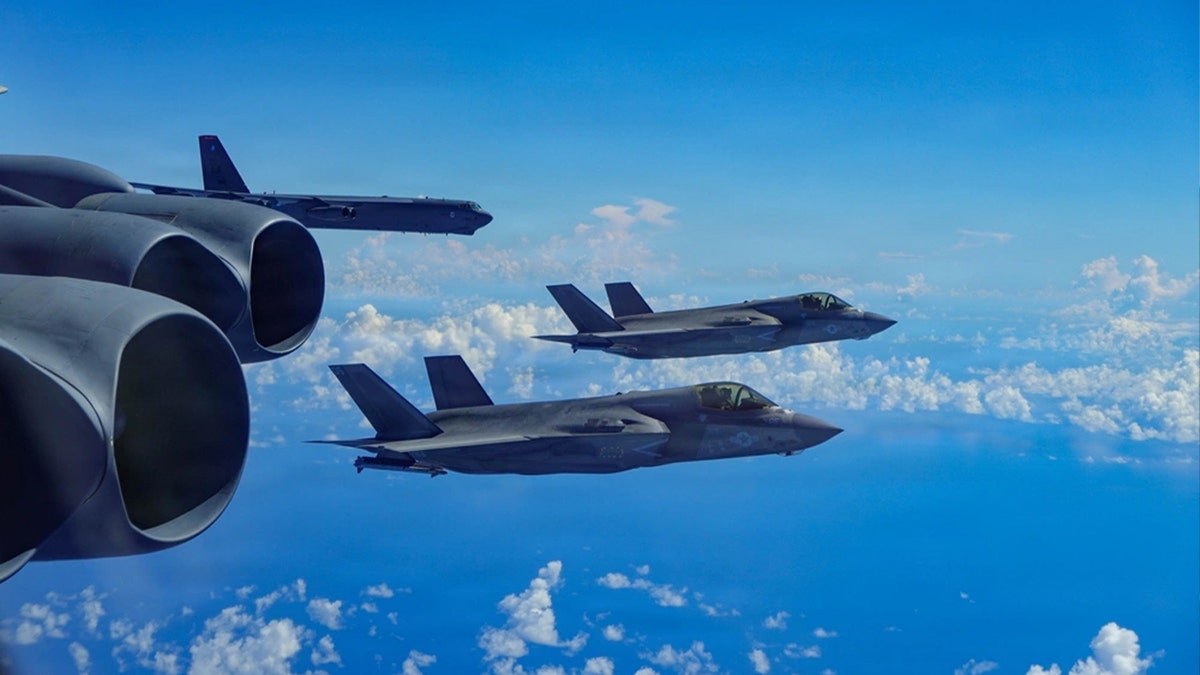
A U.S. Air Force B-52H Stratofortress bomber assigned to the 2nd Bomb Wing, integrates with a U.S. Marine Corps F-35B Lightning II aircraft assigned to the Marine Fighter Attack Squadron 225, in the U.S. Southern Command area. (U.S. Air Force)
«This is a posture we haven’t seen in the Caribbean since the early 2000s,» said one defense analyst familiar with U.S. operations in the region. «It’s clearly meant to send a message — not just to traffickers, but to governments accused of enabling them.»
Experts generally agree the U.S. buildup does not suggest preparations for all-out war.
Mark Cancian, a senior defense adviser at the Center for Strategic and International Studies, told Fox News Digital that such a campaign would require between 50,000 and 100,000 U.S. troops — far more than the roughly 10,000 currently in theater.
«What I think they’ve put in place is the capability to launch strikes at either the cartels or the Maduro regime,» Cancian said. «If I had to bet, it’s probably against the cartels — but I wouldn’t rule out something against the regime.»
That limited but flexible posture reflects what some experts describe as a modern form of coercive diplomacy.
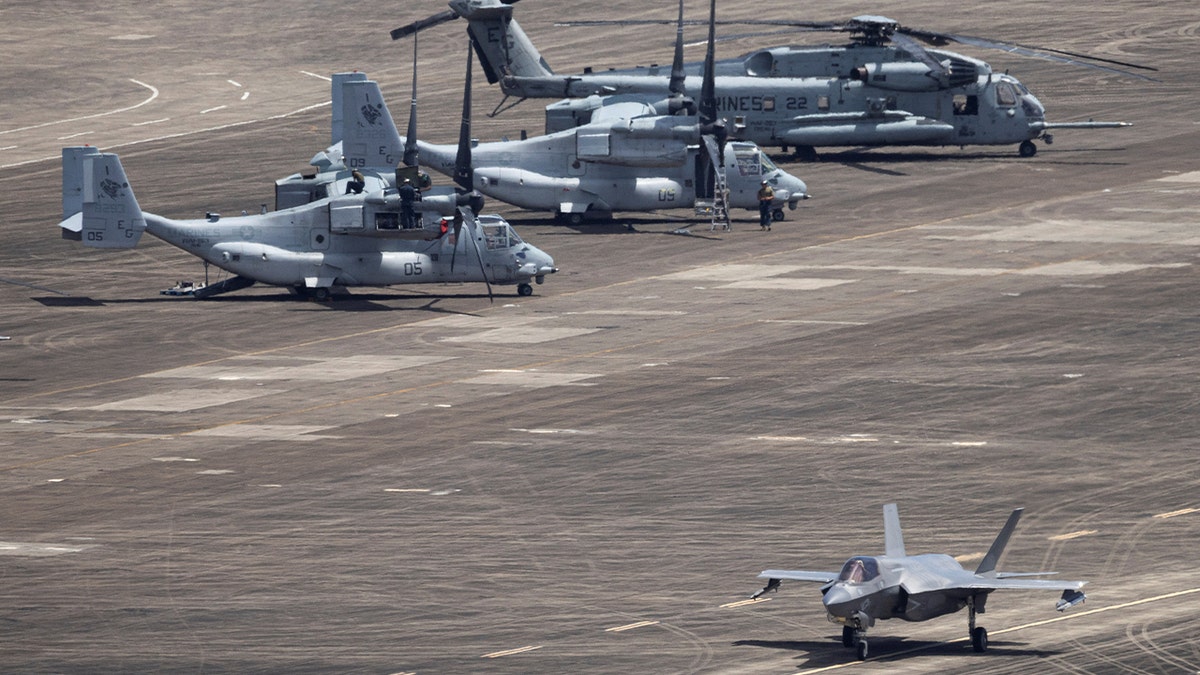
A U.S. Marine Corps F-35 fighter jet taxies on the tarmac past U.S. Marine Corps Ospreys and helicopters are now parked at the former Roosevelt Roads military base in Ceiba, Puerto Rico, which had been closed for decades. (Ricardo Arduengo/Reuters)
«It sort of looks like we’re in the throes of a 21st-century version of gunboat diplomacy,» said Brandan Buck, a foreign policy analyst at the Cato Institute. «The Trump administration is doing what it can to force some sort of transition [of] power — out of Maduro’s hands and into someone else’s — without a classic invasion.»
CLICK HERE TO DOWNLOAD THE FOX NEWS APP
Ryan Berg, director of the Americas Program at the Center for Strategic and International Studies, said the current deployment gives Washington strike options without committing to a major ground war.
«The force posture currently in the southern Caribbean is consonant with the potential for precision strikes using Tomahawk missiles or other weapons, but without risking the lives of U.S. service personnel,» Berg said.
latin america,pentagon,defense,military,caribbean

 POLITICA3 días ago
POLITICA3 días agoUn juez federal rechazó el habeas corpus presentado por Lázaro Báez y ordenó trasladarlo a la cárcel de Ezeiza

 CHIMENTOS2 días ago
CHIMENTOS2 días agoLa fuerte actitud de Manu Urcera con Indiana Cubero que reveló la verdad de la interna familiar: “El saludo del piloto a la hija de Nicole Neumann por su cumpleaños”

 CHIMENTOS2 días ago
CHIMENTOS2 días agoLa cruda confesión del Turco Naim a 1 año de la separación de Emilia Attias: «Me di cuenta que hay que aprender a estar solo»









